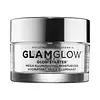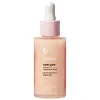GLAMGLOW GLOWSTARTER™ Versus Glossier Super Glow
What's inside
What's inside
 Key Ingredients
Key Ingredients

 Benefits
Benefits

 Concerns
Concerns

 Ingredients Side-by-side
Ingredients Side-by-side

Water
Skin ConditioningDimethicone
EmollientButylene Glycol
HumectantGlyceryl Distearate
EmollientCetyl Ricinoleate
EmollientTrisiloxane
Skin ConditioningGlyceryl Stearate Se
EmulsifyingCholesterol
EmollientSteareth-10
EmulsifyingSimmondsia Chinensis Seed Oil
EmollientButyrospermum Parkii Butter
Skin ConditioningCetyl Esters
EmollientCetyl Alcohol
EmollientGlycerin
HumectantTocopheryl Acetate
AntioxidantSodium Hyaluronate
HumectantAlgae Extract
EmollientCamellia Sinensis Leaf Extract
AntimicrobialCucumis Sativus Fruit Extract
EmollientPyrus Malus Fruit Extract
Skin ConditioningSaccharomyces Lysate Extract
HumectantScutellaria Baicalensis Root Extract
AstringentCeramide Ng
Skin ConditioningIsohexadecane
EmollientSynthetic Fluorphlogopite
Sucrose
HumectantPolysorbate 80
EmulsifyingAcrylamide/Sodium Acryloyldimethyltaurate Copolymer
Emulsion StabilisingXanthan Gum
EmulsifyingCaprylyl Glycol
EmollientHexylene Glycol
EmulsifyingCitric Acid
BufferingLinoleic Acid
CleansingPanthenol
Skin ConditioningParfum
MaskingLimonene
PerfumingCitral
PerfumingLinalool
PerfumingDisodium EDTA
Magnesium Ascorbyl Phosphate
AntioxidantSodium Citrate
BufferingPhenoxyethanol
PreservativeMica
Cosmetic ColorantCI 77891
Cosmetic ColorantCI 77491
Cosmetic ColorantCI 77492
Cosmetic ColorantCI 77499
Cosmetic ColorantCI 42090
Cosmetic ColorantCI 14700
Cosmetic ColorantCI 17200
Cosmetic ColorantCI 19140
Cosmetic ColorantWater, Dimethicone, Butylene Glycol, Glyceryl Distearate, Cetyl Ricinoleate, Trisiloxane, Glyceryl Stearate Se, Cholesterol, Steareth-10, Simmondsia Chinensis Seed Oil, Butyrospermum Parkii Butter, Cetyl Esters, Cetyl Alcohol, Glycerin, Tocopheryl Acetate, Sodium Hyaluronate, Algae Extract, Camellia Sinensis Leaf Extract, Cucumis Sativus Fruit Extract, Pyrus Malus Fruit Extract, Saccharomyces Lysate Extract, Scutellaria Baicalensis Root Extract, Ceramide Ng, Isohexadecane, Synthetic Fluorphlogopite, Sucrose, Polysorbate 80, Acrylamide/Sodium Acryloyldimethyltaurate Copolymer, Xanthan Gum, Caprylyl Glycol, Hexylene Glycol, Citric Acid, Linoleic Acid, Panthenol, Parfum, Limonene, Citral, Linalool, Disodium EDTA, Magnesium Ascorbyl Phosphate, Sodium Citrate, Phenoxyethanol, Mica, CI 77891, CI 77491, CI 77492, CI 77499, CI 42090, CI 14700, CI 17200, CI 19140
Water
Skin ConditioningMagnesium Ascorbyl Phosphate
AntioxidantPropanediol
SolventDimethicone
EmollientGlyceryl Stearate Se
EmulsifyingPolyglyceryl-10 Oleate
Skin ConditioningCaprylic/Capric Triglyceride
MaskingCetyl Alcohol
EmollientGlycerin
HumectantMagnesium PCA
HumectantSimmondsia Chinensis Seed Oil
EmollientButyrospermum Parkii Butter
Skin ConditioningHelianthus Annuus Seed Oil
EmollientEvodia Rutaecarpa Fruit Extract
Skin ConditioningMelia Azadirachta Flower Extract
Skin ConditioningMelia Azadirachta Leaf Extract
Skin ConditioningCorallina Officinalis Extract
Skin ConditioningCoccinia Indica Fruit Extract
Skin Conditioning1,2-Hexanediol
Skin ConditioningSodium Stearoyl Lactylate
EmulsifyingBetaine
HumectantSodium Citrate
BufferingXanthan Gum
EmulsifyingCaprylhydroxamic Acid
Water, Magnesium Ascorbyl Phosphate, Propanediol, Dimethicone, Glyceryl Stearate Se, Polyglyceryl-10 Oleate, Caprylic/Capric Triglyceride, Cetyl Alcohol, Glycerin, Magnesium PCA, Simmondsia Chinensis Seed Oil, Butyrospermum Parkii Butter, Helianthus Annuus Seed Oil, Evodia Rutaecarpa Fruit Extract, Melia Azadirachta Flower Extract, Melia Azadirachta Leaf Extract, Corallina Officinalis Extract, Coccinia Indica Fruit Extract, 1,2-Hexanediol, Sodium Stearoyl Lactylate, Betaine, Sodium Citrate, Xanthan Gum, Caprylhydroxamic Acid
 Reviews
Reviews

Ingredients Explained
These ingredients are found in both products.
Ingredients higher up in an ingredient list are typically present in a larger amount.
This ingredient is also known as shea butter. It is an effective skin hydrator and emollient.
Emollients help soothe and soften your skin. It does this by creating a protective film on your skin. This barrier helps trap moisture and keeps your skin hydrated. Emollients may be effective at treating dry or itchy skin.
Shea butter is rich in antioxidants. Antioxidants help fight free-radicals, or molecules that may harm the body. It is also full of fatty acids including stearic acid and linoleic acid. These acids help replenish the skin and keep skin moisturized.
While Shea Butter has an SPF rating of about 3-4, it is not a sunscreen replacement.
Shea butter may not be fungal acne safe. We recommend speaking with a professional if you have any concerns.
Learn more about Butyrospermum Parkii ButterCetyl Alcohol is a fatty alcohol. Fatty Alcohols are most often used as an emollient or to thicken a product.
Its main roles are:
Though it has "alcohol" in the name, it is not related to denatured alcohol or ethyl alcohol.
The FDA allows products labeled "alcohol-free" to have fatty alcohols.
Learn more about Cetyl AlcoholDimethicone is a type of synthetic silicone created from natural materials such as quartz.
What it does:
Dimethicone comes in different viscosities:
Depending on the viscosity, dimethicone has different properties.
Ingredients lists don't always show which type is used, so we recommend reaching out to the brand if you have questions about the viscosity.
This ingredient is unlikely to cause irritation because it does not get absorbed into skin. However, people with silicone allergies should be careful about using this ingredient.
Note: Dimethicone may contribute to pilling. This is because it is not oil or water soluble, so pilling may occur when layered with products. When mixed with heavy oils in a formula, the outcome is also quite greasy.
Learn more about DimethiconeGlycerin is already naturally found in your skin. It helps moisturize and protect your skin.
A study from 2016 found glycerin to be more effective as a humectant than AHAs and hyaluronic acid.
As a humectant, it helps the skin stay hydrated by pulling moisture to your skin. The low molecular weight of glycerin allows it to pull moisture into the deeper layers of your skin.
Hydrated skin improves your skin barrier; Your skin barrier helps protect against irritants and bacteria.
Glycerin has also been found to have antimicrobial and antiviral properties. Due to these properties, glycerin is often used in wound and burn treatments.
In cosmetics, glycerin is usually derived from plants such as soybean or palm. However, it can also be sourced from animals, such as tallow or animal fat.
This ingredient is organic, colorless, odorless, and non-toxic.
Glycerin is the name for this ingredient in American English. British English uses Glycerol/Glycerine.
Learn more about GlycerinGlyceryl Stearate Se is a self-emulsifying (SE) form of glyceryl stearate. Self-emusifying means this ingredient automatically blends with water. It is an emulsifier, emollient, and cleansing agent.
As an emulsifier, Glyceryl Stearate Se prevents ingredients such as oil and water from separating. It is also a surfactant, meaning it helps cleanse the skin. Surfactants help gather oil, dirt, and other pollutants so they may be rinsed away easily.
Emollients help your skin stay smooth and soft. It does so by creating a film on top of the skin that helps trap moisture in.
Learn more about Glyceryl Stearate SeMagnesium Ascorbyl Phosphate (MAP) is a form of Vitamin C and is an antioxidant. It can help to reduce redness, improve skin texture, reduce the effects of aging, reduce the visibility of dark spots, and brighten skin.
MAP is created by combining ascorbic acid with magnesium salt. While MAP more gentle on the skin than ascorbic acid, it is thought to be less easily-absorbed into the skin.
Due to MAP's stability up to a pH level of 7, it is more stable to air and sunlight exposure than ascorbic acid. The best pH range for MAP is between 5 and 6.
Like other forms of Vitamin C, MAP has been shown to help reduce hyperpigmentation and simulate collagen production.
As an antioxidant, it helps protect your skin against the signs of aging.
Learn more about Magnesium Ascorbyl PhosphateThis oil comes from the seeds of the desert shrub called Jojoba. It is more commonly known as jojoba oil, a non-comedogenic oil.
Jojoba oil does not contain fragrance and has many fatty-acids, making it a great soothing ingredient.
It also contains Vitamin E, a great moisturizing ingredient. Vitamin E is also an antioxidant and protects your skin against oxidative damage.
This ingredient humectant properties, meaning it helps draw moisture from the air. This helps keep your skin hydrated.
While jojoba has antibacterial properties, it is only able to kill some strains of bacteria.
Studies also show it helps in wound healing. In fact, Indigenous cultures have used jojoba as a moisturizer and to help treat burns for centuries.
Fun fact: Jojoba oil similar to natural human skin sebum, so it has a great effect on dry skin. It is also promising with helping to regulate sebum production.
Due to its fatty acid content, Jojoba oil may not be fungal acne safe. We recommend speaking with a professional if you have any concerns.
Learn more about Simmondsia Chinensis Seed OilSodium Citrate is the sodium salts of citric acid. In skincare, it is used to alter pH levels and acts as a preservative.
Its main functions are to maintain the pH of a product and neutralize metal ions.
The acidity of our skin is maintained by our glands and skin biome; normal pH level of skin is slightly acidic (~4.75-5.5).
Being slightly acidic allows our skin to create an "acid mantle". This acid mantle is a thin barrier that protects our skin from bacteria and contaminants.
Learn more about Sodium CitrateWater. It's the most common cosmetic ingredient of all. You'll usually see it at the top of ingredient lists, meaning that it makes up the largest part of the product.
So why is it so popular? Water most often acts as a solvent - this means that it helps dissolve other ingredients into the formulation.
You'll also recognize water as that liquid we all need to stay alive. If you see this, drink a glass of water. Stay hydrated!
Learn more about WaterXanthan gum is used as a stabilizer and thickener within cosmetic products. It helps give products a sticky, thick feeling - preventing them from being too runny.
On the technical side of things, xanthan gum is a polysaccharide - a combination consisting of multiple sugar molecules bonded together.
Xanthan gum is a pretty common and great ingredient. It is a natural, non-toxic, non-irritating ingredient that is also commonly used in food products.
Learn more about Xanthan Gum